|
Mental patterns
our guidance (and sometimes misguidance) system

This page is a “brainroad” ©
that explores the human brain — or mind —
as an operating mechanism—from multiple angles.
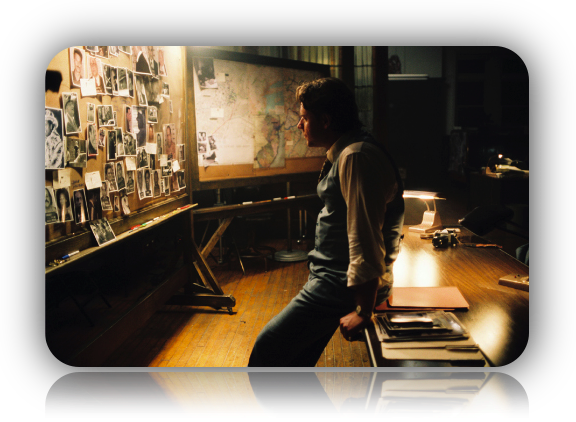
Traveling and exploring a brainroad is about looking, seeing, and maybe synthetically experiencing.
If you mentally put yourself in some kind of really dangerous situation and experience the moments of the unfolding drama, that would be a brainroad.
If you don’t get deeply involved then you’re not really going down a brainroad.
Think of a brainroad as frames in a movie rather than a still image.
Mental patterns are intertwined with ATTENTION directing and flow
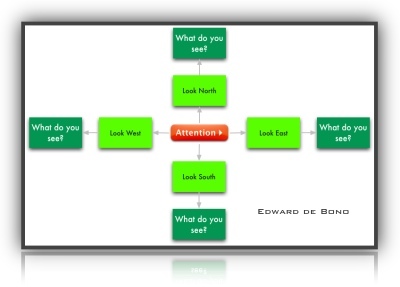
Druckerisms — attention-directing thought jewels from PFD
Almost all of the following comes from a variety of Edward de Bono books
The major relevance of this topic is the difficultly
presented by the conflict between
our existing mental patterns and
the changing social and economic picture
intertwined with organization evolution.
We are always naturally looking backwards —
even when we don’t want to be.
We need …

Different THOUGHTS for different times … and then do it again
Experts Speak
Impossible Worlds

“We know only two things about the future.
It cannot be known.
It will be different from what exists now and from what we now expect”
Peter Drucker — Chapter 10 Management, Revised Edition
Innovation
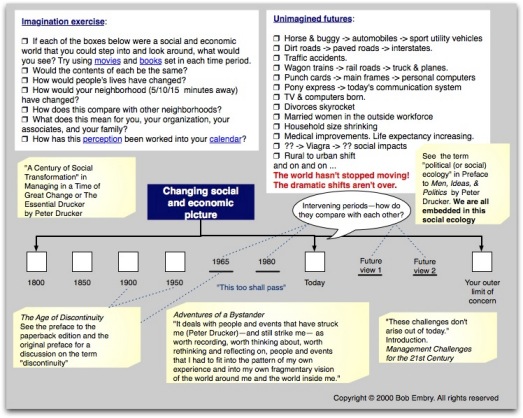
The First Technological Revolution and Its Lessons
A Century of Social Transformation

Remember those organization crisis stories
flowing through the news?
Connections
What ails the U.S. auto industry
Theory of the business
Victims of success

Key fragments for a “surface” view of the topical landscape
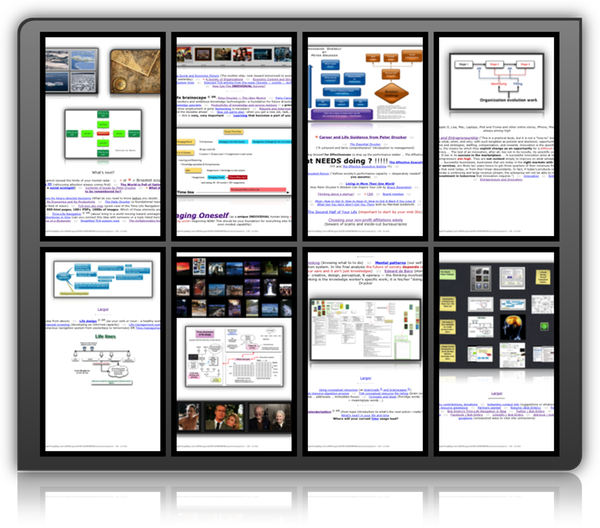
A brainscape for time investing

The patterning system of the mind
Edward de Bono is one of the world’s leading authorities in cognitive studies.
He points out that “the mind works to make sense out of confusion and uncertainty.
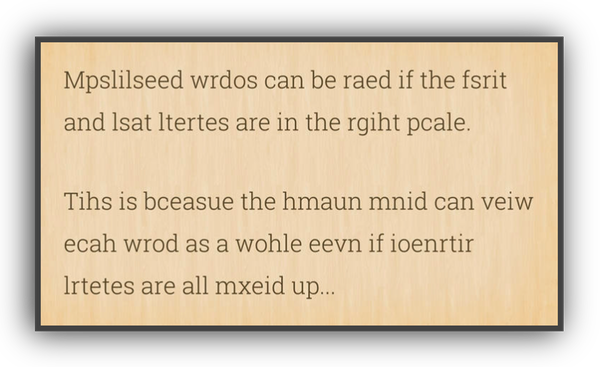
The mind works to recognize familiar patterns in the outside world.
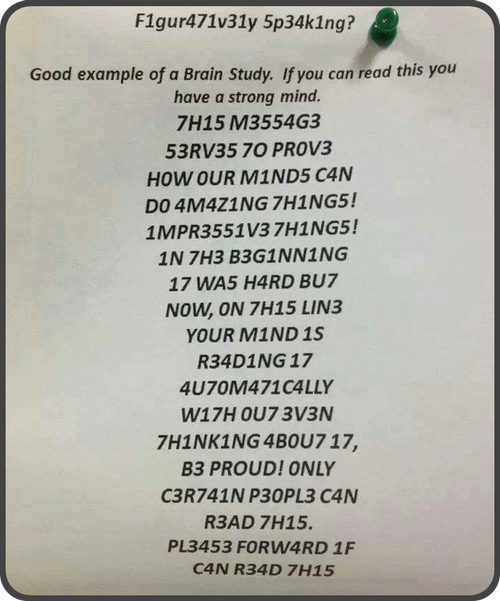
As soon as such a pattern is recognized the mind switches into it and follows it along—further thinking is unnecessary …
There is another important characteristic of the patterning system of the mind.
Unless there are competing patterns, then anything remotely similar to the established pattern will be treated just as if it were that pattern.
It is not unlike the watershed into a valley.
Unless there is a competing valley, water which falls quite far away will end up at the center of the valley.
This is what we might call ‘the centering of patterns.’”
de Bono Thinking Course

Wisdom is largely about 'broadening' perception
Most of the mistakes in thinking are mistakes in perception.
Seeing only part of the situation — insufficient information
Jumping to conclusions
Misinterpretation caused by feelings continue
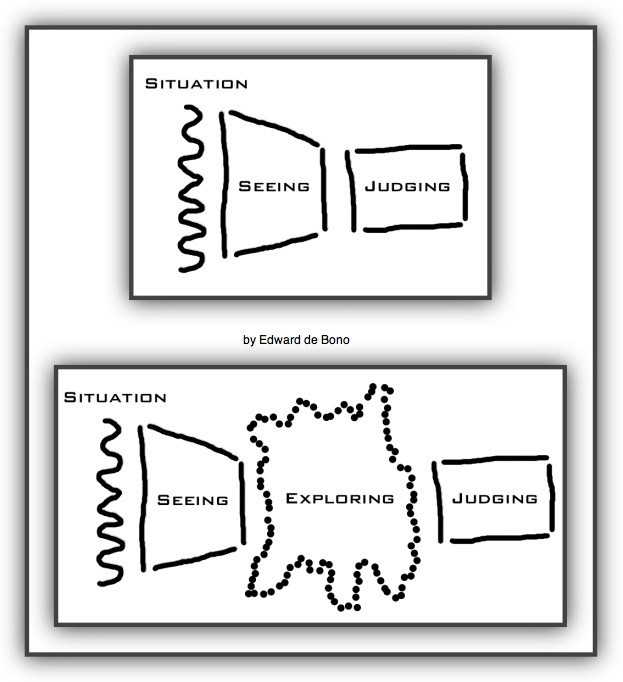

13 JUL — Unexpected Success
It takes an effort to perceive unexpected success as one’s own best opportunity.
It is precisely because the unexpected jolts us out of our preconceived notions, our assumptions, our certainties, that it is such a fertile source of innovation.
In no other area are innovative opportunities less risky and their pursuit less arduous.
Yet the unexpected success is almost totally neglected; worse, managements tend actively to reject it.
One reason why it is difficult for management to accept unexpected success is that all of us tend to believe that anything that has lasted a fair amount of time must be “normal” and go on “forever.”
This explains why one of the major U.S. steel companies, around 1970, rejected the “mini-mill.”
Management knew that its steelworks were rapidly becoming obsolete and would need billions of dollars of investment to be modernized.
A new, smaller “mini-mill” was the solution.
Almost by accident, such a “mini-mill” was acquired.
It soon began to grow rapidly and to generate cash and profits.
Some of the younger people within the steel company proposed that available investment funds be used to acquire additional “mini-mills” and to build new ones.
Top management indignantly vetoed the proposal.
“The integrated steelmaking process is the only right one,” top management argued.
“Everything else is cheating—a fad, unhealthy, and unlikely to endure.”
Needless to say, thirty years later the only parts of the steel industry in America that were still healthy, growing, and reasonably prosperous were “mini-mills.”
Film to Point-and-shoot to Smartphones
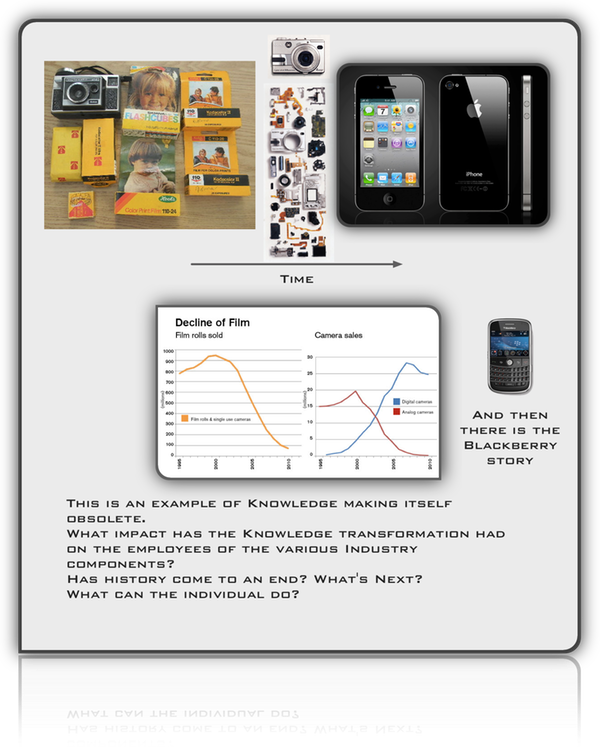
See Experts Speak below
Connect, only connect — knowledge, its economics and productivity are critical to everyone’s future
Competing patterns ↓
The Daily Drucker
Wisdom
 
Amazon links: The Daily Drucker: 366 Days of Insight and Motivation for Getting the Right Things Done and
Edward de Bono's Textbook of Wisdom
"A View of Japan Through Japanese Art" in Toward the Next Economics and Other Essays
Part I: Management's New Realities in
Management, Revised Edition

Danger
Unless you do something different you will take the mental patterns of yesterdayS into tomorrowS without realizing it.
This tendency lies behind every crisis: political, corporate, personal, career, relationship …
Try to keep the idea of navigating a changing world in mind while reading the remainder of the page — you'll be traveling a brainroad.

Practical Thinking — knowing what to do
There is no law requiring one to think for oneself or to make one's own ideas.
In important matters it is usually easier to accept other people's ideas ready-made and this saves one the trouble of doing any thinking for oneself—though one may still have to do it in minor matters.
Often one has no choice but to accept the ideas of others because thinking things out for oneself can be so difficult.
Education unfortunately provides little help in this matter.
You can probably remember things you were taught at school about …
The black cylinder experiment and its relevance
Political / social ecology
It also implies that society, polity and economy are a genuine environment, a genuine whole, a true “system,” to use the fashionable term, in which everything relates to everything else and in which men, ideas, institutions, and actions must always be seen together in order to be seen at all, let alone to be understood.
What everyone knows is frequently wrong
Three kinds of intelligence (Niccolò Machiavelli) and people behaviors
Knowledge and research
“To know something,
to really understand something important,
one must look at it from sixteen different angles.
People are perceptually slow,
and there is no shortcut to understanding;
it takes a great deal of time.” — PFD
Beyond the Numbers Barrier
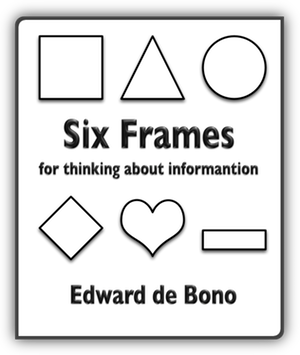
Six Frames For Thinking about Information

Drucker Essay Collections
Although written years ago, these essays can be valuable attention directing tools. They can take your brain to places (brain addresses and brain roads) it wouldn't naturally go. What has changed and what is likely to change?
 Technology, Management and Society Technology, Management and Society
 Men, Ideas & Politics Men, Ideas & Politics
 Toward the Next Economics and Other Essays Toward the Next Economics and Other Essays
 The Ecological Vision: Reflections on the American Condition The Ecological Vision: Reflections on the American Condition
 A Functioning Society: Selections from Sixty-Five Years of Writing on Community, Society, and Polity A Functioning Society: Selections from Sixty-Five Years of Writing on Community, Society, and Polity
“Managers are synthesizers
who bring resources together
and have that ability to “smell” opportunity and timing.
Today perceptiveness is more important than analysis.
In the new society of organizations,
you need to be able to recognize patterns
to see what is there
rather than what you expect to see.”
— Interview: Post-Capitalist Executive
Information executives need: going outside
This introduction (above) to brain operations only scratches the surface. To get a better overview see I am Right, You are Wrong by Edward de Bono. A sample selection follows:
PATTERN-MAKING: the brain works by providing an environment in which sequences of activity become established as patterns.
Could you afford to spend forty-five hours getting dressed every morning?
If not, be grateful that the brain sets up sequence patterns
One day a young man decided to figure out in how many ways he could get dressed using his standard eleven items of clothing.
He set up his personal computer to do the work for him.
The computer worked for forty-five hours non-stop to show that out of the 39 million possible ways of putting on eleven items of clothing only about five thousand were possible (you could not put your shoes on before your socks etc.).
The figure of 39 million is easily obtained because you have eleven choices of the first item and then for each of these ten choices of the next, so you multiply 11 x 10 x 9 x 8 X 7 X 6 X 5 X 4 X 3 X 2.
When you pour out a glass from a bottle of Saint-Véran you do not have to work out which way up to put the glass.
When you drink from it you do not have to work out the best way to hold it or whether to put it to your mouth or your ear.
Your patterns may even have told you that Saint-Véran is a white wine from the Burgundy area and a very recently accepted French appellation (or you may be establishing that pattern right now).
The definition of a sequence pattern is very simple.
At any moment there is one direction of change which has a much higher probability of occurring than any other.
For a railway train going along tracks at any moment the probability (or likelihood) of going forward along the track is rather higher than of going in any other direction.
In the brain the change from the present state of activity to the next is more likely to occur in one direction (to one particular next state) than in any other.
The natural and inescapable behaviour of our self-organizing brain model is that it is a pattern-making and pattern-using system.
That is its natural activity, it cannot do anything else.
Rain falls on a virgin landscape.
Eventually the interaction of the rain and the landscape forms streams and rivers.
The newly arriving rain now follows these patterns.
That is the natural behaviour of the system.
A person blind from birth is suddenly made capable of seeing.
But that person cannot yet see, for everything is a blur.
It takes some time for the brain to set up patterns of seeing.
If the brain were not a pattern-making system we would not be able to read, write or talk.
Every activity, like getting dressed in the morning, would be a major time-consuming task.
Sport would be impossible—for example, a golfer would have consciously to direct every part of every swing.
Consider the millions of people who drive along the roads every day using patterns of perception and reaction and only occasionally having to work things out.
There are routine patterns of action, like driving or playing golf.
There are routine patterns of perception, which is why we can recognize knives, forks and people.
There are routine patterns of meaning, which is why we can listen and read and communicate.
Traditional computers have to struggle quite hard to make and recognize patterns.
The brain makes patterns very easily and recognizes them instantly.
This is the very nature of the brain and arises directly from the way self-organizing systems work.
TRIGGER: the brain will reconstruct the whole picture from just part of it or a sequence can be triggered by the initial part.
ASYMMETRY: the sequence patterns are asymmetric and this gives rise to humour and to creativity.
INSIGHT: if we enter the pattern sequence at a slightly different point we may follow a short cut. We can rely on chance to bring this about or do it deliberately.
LEARNING BACKWARDS: there is good reason to believe that learning things backwards is much more effective than learning them forwards.
SEQUENCE: the brain is a history recorder and the patterns are highly dependent on the initial sequence of experience.
CATCHMENT: each pattern has a very wide collection basin so that a variety of inputs will give the same output.
KNIFE-EDGE DISCRIMINATION: the boundary between two catchment basins is very sharp, so very clear distinctions may be made between things which are quite similar—provided the patterns are in place.
PRE-EMPTION: once a pattern exists it is very hard to cut across it to establish a new pattern.
MISMATCH: if what is offered to the brain contradicts what is established as pattern the brain notices this strongly.
READINESS: the patterns in the brain are not solely in an active/inactive state but there is a 'readiness' to go which is dependent on context and emotions.
CONTEXT: the actual patterns that emerge are determined by history, by activity at the moment and also by context which sets the background readiness level of different patterns.
CIRCULARITY: a circularity can be established in which patterns lead back into each other. This is the basis of belief systems.
MAKING SENSE: the brain has a powerful ability to put together and to seek to coalesce into sense whatever is put before it.
ATTENTION: there is unitary attention which may take in the whole field or focus on part of it, ignoring the rest.
RELEVANCE AND MEANING: attention will move to those areas which trigger existing patterns.
NO ZERO-HOLD: the activity in the brain cannot stabilize into a zero-hold which accepts input but does not seek to follow an accepted pattern
See Creativity Workout for an exploration of creativity and some thoughts on brainstorming
The Experts Speak by Christopher Cerf and Victor Navasky
Examples of mental patterns leading to stupid conclusions.
[W]hen the Paris Exhibition closes electric light will close with it and no more will be heard of it.
Erasmus Wilson,
professor at Oxford University, 1878
Well-informed people know it is impossible to transmit the voice over wires and that were it possible to do so, the thing would be of no practical value.
Editorial in the Boston Post, 1865
There is no reason for any individual to have a computer in their home.
Ken Olsen,
president of Digital Equipment Corporation,
at the Convention of the World Future Society, 1977
640K [of RAM] ought to be enough for anybody.
Bill Gates, 1981
Heavier-than-air flying machines are impossible.
Lord Kelvin,
British mathematician, physicist, and
president of the British Royal Society, circa 1895
Everything that can be invented has been invented;
Charles H. Duell,
Commissioner, U.S. Office of Patents, 1899
10 Worst Tech Predictions of All Time
In the technology world, bold predictions abound, and they should. Placing big bets in one direction or another is how this industry works. Some pundits try to make educated guesses about where tech is headed, while others prognosticate in reaction to disruptive technologies that could boost (or threaten) their business.
As we all know, foretelling what’s going to happen in 5, 10 or 30 years is pretty much impossible, but some predictions are so spectacularly wrong that they should be immortalized. That’s why I’ve selected these gems from some of the biggest names, publications and research firms to present the 10 worst tech predictions of all time. A couple of these timelines haven’t yet passed, but I feel comfortable predicting them as total fails now.
The iPhone Has No Chance
“There’s no chance that the iPhone is going to get any significant market share.”
Steve Ballmer, Microsoft CEO (April 2007)
Back in 2007, the world was in a frenzy over the iPhone (aka the Jesus Phone), which combined a widescreen iPod with a full-fledged browser and introduced the masses to multi-touch displays. Steve Jobs claimed that the iPhone was five years ahead of the competition, but the head of Microsoft wasn’t having it.
In April of that year Steve Ballmer told USA Today that “there’s no chance that the iPhone is going to get any significant market share. No chance.” Ballmer cited the iPhone’s relatively high $499 subsidized price as one of the reasons the device would flop. Fast forward to 2013 and the iPhone commands 42 percent of U.S. smartphone market share and 13.1 percent worldwide.
Who Needs a Home PC?
“There is no reason anyone would want a computer in their home.”
Ken Olson, president Digital Equipment Corp (1977)
The setting was (ironically) the World Future Society meeting in Boston, and the speaker was Ken Olson, the president, chairman and founder of Digital Equipment Corporation. Olson did in fact say that “there is no reason anyone would want a computer in their home,” but he claims his statement was taken out of context.
The head of the leading low-cost minicomputers maker said he was referring to computers that control every aspect of your home. Nevertheless, DEC would lose the mainframe war to IBM and would never gain traction in the personal computing market. Olsen was replaced as CEO in 1992 and the company was sold to Compaq in 1998. While in a state of decline, IDC expects PC sales to total 345 million in 2013.
Flying Cars By 1944!
“Within the next two decades autos will be made with folding wings.”
Eddie Rickenbacker, pilot (1924)
You could say that this famous pilot was ahead of his time. Way ahead. In July 1924 Eddie Rickenbacker wrote in Popular Science Monthly that we would have flying cars within 20 years. This combo auto-airplane would “have a body shapred similar to the present hydroplane hull, making it both a water and land machine. Rickenbacker also claimed that the 25-feet wings would fold back against the sides of the car when driving.
Even though 69 years have flown by—along with the Jetsons’ flying car and Back to the Future’s flying DeLorean—innovators haven’t given up. The Terrafugia Transition, dubbed a “roadable aircraft,” just made its first public flight. It’s the first street-legal airplane that converts between flying and driving modes in less than a minute. The company claims that you can fly into any of 5,000 public U.S. airports, and you can pre-order one for just $279,000. Production begins in 2015.
Tablet Deathwatch
“In five years I don’t think there’ll be a reason to have a tablet anymore.”
Thorsten Heins, BlackBerry CEO (2013)
Maybe he was trying to put the ill-fated PlayBook tablet behind him, or maybe he just forgot about a little thing called the iPad. Whatever the reason, Thorsten Heins started a firestorm of bad PR when he told Blooomberg the following: “In five years I don’t think there’ll be a reason to have a tablet anymore…Tablets themselves are not a good business model.” A month later Heins walked back his comments, saying “We’re interested in the future of tablets, whatever that is.” Too late.
Tablet sales are still very much on the rise, growing 142 percent year over year in the first quarter of 2013. During the second quarter of 2013, 34.6 million Android tablets shipped, compared to 2.7 million BlackBerry 10 phones. Even with a drop in sales, Apple moved 14 million iPads. Last but not least, the Los Angeles School District recently ordered iPads for 640,000 students. I guess Heins should break the news they just bought an obsolete technology.
Steve Jobs Trashes Music Subscriptions
“The subscription model of buying music is bankrupt.”
Steve Jobs (2003)
The late founder and CEO of Apple, Steve Jobs was right about a lot of things, including predicting the Post-PC era and the death of Flash (though Apple helped). Jobs was also correct when he said in 2003 that the iTunes Music Store would “go down as a turning point for the music industry.” In February 2013, the 25 billionth song was purchased form the store. However, Jobs was wrong about digital music’s evolution.
That same year Jobs told Rolling Stone that he didn’t think subscription-based music services such as Rhapsody would fly. “I think you could make available the Second Coming in a subscription model and it might not be successful,” Jobs said. Today, Spotify has more than 6 million paid subscribers who can listen to all the tunes they want for a flat monthly fee. The new iTunes Radio service will let you skip ads for a $24.99 yearly fee that ties into iTunes Match, but you won’t be able to stream your favorite tracks on demand.
Bonus: Steve Jobs also called 7-inch tablets “dead on arrival” in 2010. Oops.
Remote Shopping Will Flop
“Remote shopping, while entirely feasible, will flop.”
Time Magazine (1966)
If you put yourself back in the Mad Men era, you could certainly understand why many doubted that remote shopping would take off. It was a different time indeed, when the closest thing to an Amazon was a Sears Christmas Wish Book Catalog. For the record, it totaled 605 pages, with 225 pages devoted to toys and 380 pages to gifts for adults.
Here was Time Magazine’s reasoning for saying remote shopping would flop: “Because women like to get out of the house, like to handle merchandise, like to be able to change their minds.” E-commerce would change all of that, allowing both women and women to browse and virtually try on all sorts of goods before adding them to their digital shopping carts. According to eMarketer, e-commerce sales topped $1 trillion for the first time in 2012, and Amazon alone raked in $15.7 billion in the second quarter of 2013.
Windows Phone Forecast Fail
Windows Phone will be No. 2 in Smartphones by 2015
IDC, Gartner, IHS
Fresh off the honeymoon of Nokia’s and Microsoft’s strategic partnership, analyst firms believed that the two companies would make beautiful music together in the smartphone market. In fact, three separate firms predicted that Windows Phone would unseat Apple’s iOS by 2015. “The new alliance brings together Nokia’s hardware capabilities and Windows Phone’s differentiated platform,” said Ramon Llamas in 2011, research manager for IDC. “By 2015, we expect Windows Phone to be the No. 2 operating system.” Oh boy.
Windows Phone has indeed grown from 2.9 to 4 percent in the U.S., according to Kantar Worldpanel, and the new 41-megapixel Nokia Lumia 1020 is the best camera phone ever. However, this platform isn’t anywhere close to the No. 2 spot. As Apple gained more distribution through multiple carriers worldwide and pumped out successful sequels, IDC and others revised their forecasts. “Everybody is looking at who’s going to be No. 3,” Llamas says now, “and that’s between Windows Phone and BlackBerry.”
The Internet Collapses
“I predict the Internet in 1996 [will] catastrophically collapse.”
Robert Metcalfe (1995)
Did you know the person who co-invented Ethernet predicted the demise of the Web? Robert Metcalfe told InfoWorld in 1995 that “the Internet will soon go spectacularly supernova and in 1996 catastrophically collapse.” Three years later, he would literally eat those words on stage after running his column through a blender.
So why did Metcalfe go out on this limb? He was opining about capacity and whether the infrastructure of the web would hold up under ever-increasing demand. He didn’t stop there. In 2011 Metcalfe told TechCrunch that there is a social networking bubble. “It will burst like all previous bubbles have.” Watch out, Facebook!
HP Tops the Tablet Charts
“We’re going to become better than No. 1 (in tablets).”
Eric Cador senior VP, Hewlett Packard (2010)
HP was pretty bullish on webOS when it acquired Palm for $1.2 billion in 2010. The platform would be the linchpin for HP’s mobile strategy, starting with the TouchPad tablet. Confidence was running so high that Eric Cador, vice president of HP’s Personal Systems Group for Europe, Middle East and Africa, was certain that HP’s PC success would translate to the tablet market.
“In the PC world, with fewer ways of differentiating HP’s products from our competitors, we became No. 1; in the tablet world we’re going to become better than No. 1. We call it No. 1-plus.” Not so much. In our review we panned the TouchPad’s sluggish performance, weak battery life and skimp app selection. HP would kill off the TouchPad and all webOS hardware just 7 weeks later after staggeringly weak sales.
Bonus: From HP chairman Ray Lane in Sept 2011, after the Touchpad was discontinued: “You cannot develop serious portable applications on Android.”
Landlines Rule
“Cellular phones will absolutely not replace local wire systems.”
Marty Cooper, inventor (1981)
It doesn’t get more ironic than this. The very person who is credited for being the father of the cell phone didn’t see the true potential of his earth-shattering innovation. In 1981, Marty Cooper, then director of research at Motorola, told the Christian Science Monitor why the portable phone wouldn’t replace the landline anytime close to soon. “Even if you project it beyond our lifetimes, it won’t be cheap enough,” Cooper said.
To be fair, Cooper saw how cellular phones (even the bricks of the time) would let people be more mobile. “People don’t realize how tied they are to a single place,” he argued.
According to the most recent National Health Interview Survey, the number of U.S adults with a mobile phone but no landline rose to 34 percent in the first half of 2012. The number of adults with a landline and no mobile? That’s 8 percent.
This story was provided by Laptopmag.com, a sister site to LiveScience.
Copyright 2013 LiveScience, a TechMediaNetwork company. All rights reserved.
Similar statements—reflecting the speaker's limited mental patterns—are in the news almost every day.
Trying to predict the future is like driving down a country road at night
with no headlights on and
looking out the back window — Peter Drucker
Using ignorance to your advantage

Our mental patterns create and reflect our expectations
What we do is largely a function of our mental patterns which began forming during our childhood at a specific point in time (1900, 1920, 1940, 1960, 1980 ....) See life lines for a little different perspective.
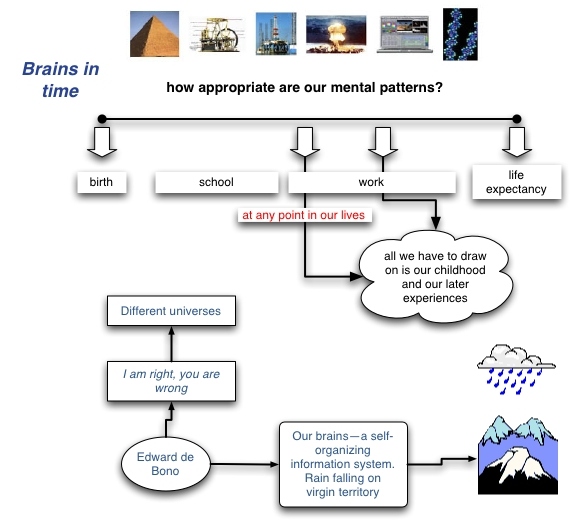
In the bottom part of illustration above, rain falls on a virgin landscape.
Over time the rain becomes organized into streams, tributaries and rivers.
This is called a self-organizing system because the rain and the landscape together organize themselves into the pattern of water flow.
Self-organizing systems set up patterns.
Once we are on a pattern we have no choice but to flow along that pattern.
The patterns are fixed for a set of circumstances, but if the circumstance changes the patterns can be different.
So the true model is not a fixed landscape but several alternative landscapes.
The top, middle and bottom parts of the illustration can be viewed as a constellation of ideas—a perception of reality.
Differences in mental patterns are the source of many disagreements.
Our mental patterns prevent us from sticking our hand in boiling water.
What boxers do in the ring reflects their mental patterns—no time to think.
The sensation of being lost or disoriented comes from a lack of mental patterns (strange city, cockpit of an unfamiliar airplane, rocket science for people who are not rocket scientists, setting the clock on our VCR).
Training seeks to create new mental patterns.
Some educational programs seek to broaden mental patterns while creating mental walls at the same time.
Politicians pander to mental patterns.
Confidence schemes play on the mark's mental patterns.
When we drop something we expect it to go down not up. This expectation is the result of our mental patterns.
Whenever we think or say something it reflects our mental patterns and expectations about how the world works now and in the future. The same goes for other people.
My assertion isn't that we need to be accepting or tolerant of differing mental patterns, but that we need to be suspect of all mental patterns.
Historically speaking its hard to find any right and permanent answers but sometimes things seem to work and this reinforces the associated mental patterns.
As an approach we need to look broader and deeper into the future on a regular basic (calendarized) while remembering a couple of things that Peter Drucker once observed about the future: It going to be different and its going to be different from what we now expect
It might be helpful to discover and then test the mental patterns on our radar.
Drucker and Complexifying
Rubin: You never seem to lose sight of the big picture. What keeps you from getting bogged down in details?
Drucker: We can’t learn anything by simplifying difficult issues. We’ve got to complexify them.
Drucker looks for simplicity but likes to convey complexity.
He loves simplicity but realizes that getting there means making connections: to the past, to related fields.
He answers questions by trotting through history, art, science.
Listening to him, you learn not just the answer but also how to make connections between disparate subjects and thus deepen your understanding.
It makes you, the listener, more valuable as an adviser and teacher.
History is Drucker’s primary tool for complexifying.
“I’m not a professional historian,” he says, “but I’ve learned that nothing helps me as much in my work as a little bit of historical knowledge about a country, technology, or industry.
Every few years I pick another major topic and read in it for three years.
It’s not long enough to make me an expert, but it’s long enough to understand what the field is all about.
I’ve been doing this for 60 years.”
His current project is Chinese history.
“I’ve studied some of the 87 volumes written by Joseph Needham on the history of Chinese science and technology,” he says.
“Needham started out with the axiom that everything worthwhile had its beginning in China.”
But since China never had much interest in society or the economy, Drucker won’t stop there, he says …
Peter's Principles
Possibility
Educational establishments totally underestimate the importance of "possibility."
Two thousand years ago, China was far ahead of the West in science and technology.
They had rockets and gunpowder.
Had China continued at the same rate of progress, then today China would easily have been the dominant power in the world.
What happened?
What brought progress to a halt?
The Chinese scholars started to believe you could move from "fact to fact."
So they never developed the messy business of possibility (hypothesis, etc.).
As a result, progress came to a dead end.
Exactly the same sort of thing is happening in the world today.
Because of the excellence of computers, people are starting to believe that all you need to do is to collect data and analyze it.
This will give you your decisions, your policies and your strategies.
It is an extremely dangerous situation, which will bring progress to a halt.
There is a huge need for creativity to interpret data in different ways; to combine data to design value delivery; to know where to look for data; to form hypotheses and speculations, etc., etc.
I (Edward de Bono) have held academic positions at the universities of Oxford, Cambridge, London and Harvard.
I have to say that at each of these wonderful institutions the amount of time spent on the fundamental importance of possibility was zero.
Our culture and habits of thinking insist that we always move towards certainty.
We need to pay equal attention to possibility.
Creativity Workout
The following quotes were selected from a variety of Edward de Bono's books:
Information Is Not Enough
...
snip, snip ...
In many cases information is enough and will do our thinking for us.
But there are times when this is not so and when the belief that it is so can be limiting.
When most people enter a new field, in research or in business, they want to read all they can about this new field.
They want to absorb all the information first and then to start to do their own thinking.
This is a very natural thing to do but it could be wrong.
When you have read all the information that is available from the experts in the field then your mind will be forced to use the concepts and perceptions that are traditional in that field.
It will be extremely difficult to generate new ideas.
It is true that you can challenge the existing ideas and set off in an opposite direction.
But it is virtually impossible to have a slightly different idea because you will immediately be pulled back into the channel of the traditional idea.
So what is the alternative? Can we really think usefully about a field if we do not know the field at all?
We can start out to read something about the field.
Just enough to give us a 'feel' for the field.
Just enough to sense the 'idiom' of the field.
Then we stop and do our own creative thinking.
We think up new concepts, new perceptions and new ways of doing things.
Then we go back and read some more.
Then we stop again to do our own thinking.
Finally we go back and read all there is to read.
In this way we are seeing the field through some of our own ideas.
There is therefore much more chance of developing fresh ideas.
This is the creativity of innocence.
There is a widespread belief that if you analyse information, this will give you new ideas.
This is not so.
Analysing information will allow you to select from the standard ideas you already have in mind.
Think “big data” and information challenges.
You might even combine some of these standard ideas.
But you will not 'see' a new idea.
The mind can only 'see' what it is prepared to see.
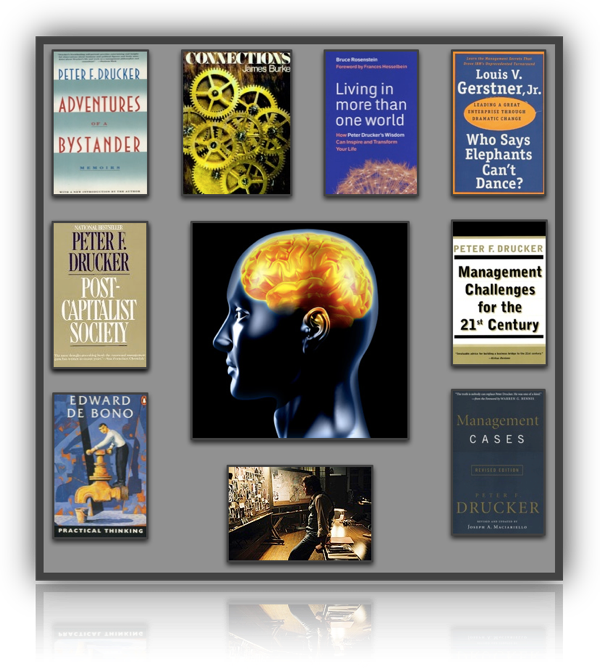
Conceptual resources
Therefore you need to start the idea in your mind as a speculation, a guess, a possibility or a hypothesis.
Then you look at the data through this guess and see if the data supports the guess.
Thinking
Wisdom is a broad ability to look at the world and to look at one's looking
If a man is to be master of his own enjoyment of life he is going to have to do some thinking for himself unless he is content to let circumstances and other people do it for him.
Bertrand Russell claimed that man was more frightened of thinking than of anything else.
This is because many people believe that thinking involves having to solve a complicated mathematical or logical problem.
But that is only a tiny part of thinking.
Thinking is having to decide whether you want a chocolate ice-cream or a vanilla one.
Thinking is telling a funny story.
Thinking is going over in your mind a pleasant experience.
Thinking is imagining what might happen next in the television thriller.
Thinking is the exploration and use of experience.
That use includes enjoyment, problem-solving and the setting of objectives.
Thinking is like moving your finger over your own, personal, internal map of the world.
The roads are the patterns created by perception.
Some roads are more clearly marked than others and there may be areas with too few roads.
Reactive And Pro-Active Thinking
In school it is very practical to put work-sheets, textbooks, and blackboard texts in front of students.
The students are then asked to ‘react’ to what is before them.
For these practical reasons almost all the thinking taught in school is ‘reactive’.
‘Here is something—what do you think of it?’
You cannot easily ask students to go out and organize a business.
You cannot easily ask students to solve a real problem or undertake a real project.
It simply is not practical in a school setting.
It also happens that this reactive type of thinking fits in with the intellectual tradition of scholarship: how do we react to what is already in existence?
But school and education is not a game unto itself.
Real life involves a great deal of ‘pro-active’ thinking.
This means going out and doing things.
All the information is not given—you have to find it.
Something is not placed before you.
If you just sit in your chair nothing will happen.
It is easy enough to eat in a restaurant if the meal is placed before you.
But buying the food (or even growing it) and cooking it are different matters.
It is not the fault of education that pro-active thinking is not so easy to handle as reactive thinking.
But it is the fault of education to suppose that reactive thinking is sufficient.
Exlectics and dialectics
With the new process of exlectics suggested in the new meta-system the emphasis is on the positive, constructive aspects of the evolution of new ideas instead of on the negative clash aspects.
In Darwin’s evolutionary model the emphasis has shifted from the struggle-for-survival stage to the mutation stage.
“How do we change an idea into a better one?”, instead of “How do we batter an idea into a better one?” It is a matter of building on ideas, improving them and perhaps changing them rather than criticizing them.
The exlectic process recognizes that construction will be slow to happen unless someone sets out deliberately to be constructive.
It is not suggested that negatively minded people are incapable of being constructive but that they need to be pointed in a constructive direction.
Starting-point
The starting-point for thinking is always an exploration of the inner world created by perception.
The perception may be of something which is:
immediately present (but we only understand it in terms of experience) or
of matters which are not present at the moment (like financial planning or budgeting).
The main problem here is one of drift.
People wait for ideas to come into their minds and then drift from point to point.
The examination of each point may be excellent, but the points are only an arbitrary sample of the whole situation.
If you rely on one point to generate the next one you will have the characteristic point-to-point thinking of young children.
To avoid this there is a need for a definite framework of attention which includes scan, focus and analysis.
Outer world—inner world
The original title of this section was going to be “Perception and Reality.”
In the traditional way this would have suggested that there was reality “somewhere out there” and then there was perception which was different from reality.
But perception is just as real as anything else—in fact perception is more real for the person involved.
A child’s terror at a moving curtain in the night is very real.
A schizophrenic’s anguish at inner voices is very real.
In fact, perception is the only reality for the person involved.
It is not usually a shared reality and may not check with the world out there, but perception is certainly real.
Attention Directing
“What time is it?”
“How old are you?”
“Did you like the soup?”
“Do you want some more coffee?”
“What is the current exchange rate between the US dollar and the Japanese yen?”
“At what temperature does this plastic melt?”
All questions are attention-directing devices. We could easily drop out “questions” and instead ask people to direct their attention to specified matters.
See Drucker questions in The Definitive Drucker
“Direct your attention to the time.”
“Tell me the time.”
“Direct your attention to your age and tell me what you find.”
“Direct your attention to the melting-point of this plastic and tell me what you know.”:
An explorer returns from an expedition to a newly discovered island.
The explorer reports on a smoking volcano and a bird that could not fly.
But what else was there?
The explorer explains that those were the two things that caught his attention.
That was not good enough.
So the explorer was sent back with specific instructions to use a very simple attention-directing framework.
“Look north and note what you see.
Then look east and note what you see.
Then look south and note what you see.
Then look west and note what you see.
Now come back and give us your notebook.”
The N-S-E-W instructions provided a very simple framework for directing attention.
Our attention usually flows in three ways:
1. What catches our interest or emotional involvement at the moment.
2. Habits of attention established through experience and practice.
3. A more or less haphazard drift from one point to another.
A great many of the deliberate processes of thinking involve a specific direction of attention.
Socratic questioning is just such a direction of attention.
There is nothing magical about it.
The CoRT Thinking Programme for schools (to be described later) includes a number of attention-directing tools.
For example the OPV tool asks the thinker to direct his or her attention to the views of the other people involved.
Some thinkers might have done this automatically.
Most do not.
So there is a need for a deliberate attention-directing tool.
The important process of analysis is an attention-directing instruction.
“Direct your attention to the component parts making up this situation.”
“Direct your attention to the different influences affecting the price of oil.”
“Direct your attention to the various factors involved in the effectiveness of a police operation.”
“Direct your attention to the parts making up a skateboard?”
“Direct your attention to the ingredients of our current strategy.”
Comparison is another fundamental “attention-directing instruction.”
“Direct your attention to the points of similarity between these two proposals.”
“Direct your attention to the points of similarity and the points of difference between the two pipes of packaging.”
“Direct your attention to the relative advantages and disadvantages of these two routes to the seaside.”
“Compare these two microwave ovens. Direct your attention to how they compare on price, capacity, reputation of maker, service, etc.”
For attention-directing we can use a deliberate external framework (as with the CoRT tools) or we can use simple internal instructions such as analyze and compare.
Another form of attention-directing is the request to focus on some aspect of a situation.
“I want you to focus on the political effect of raising the tax on diesel oil.”
“I want you to focus on the security, arrangements at the banquet.”
“I want you to focus on who is going to exercise this dog you want to buy.”
“I want you to focus on the benefits of going to a technical college.”
“I want you to focus on the disadvantages of taking this fixed-interest mortgage.”
In the Six Thinking Hats framework (to be discussed later) this focusing is obtained by an external framework.
For example, use of the “yellow hat” implies an exclusive focus on the values and benefits in the situation under discussion.
Use of the “black hat” implies an exclusive focus on the dangers, problems, drawbacks and caution points.
Although most people claim to carry out attention-directing internally, in practice they do not.
For example, in a group of highly educated executives one half were asked to judge a suggestion objectively and the other, random, half were asked to use the yellow and black hats, deliberately.
Those using the hats turned up three times as many points as the others.
Yet most of the others would claim always to look at the “pros and cons” in any situation.
That is why it is sometimes necessary to have external, formal and deliberate attention-directing tools.
They may seem simple and obvious but they are effective.
For more on attention
Recognition and Fit
A common child’s activity toy consists of a box or board with different-shaped holes in it.
The child is required to put different-shaped blocks or pieces into the different-shaped holes.
Some fit and some do not fit.
Someone is coming towards you from a distance.
You have no reason to expect a particular person.
As the person gets closer you begin to think that you might recognize her.
She gets close and suddenly you are sure: recognition “clicks”; there is a fit.
A wine expert tastes wine from a bottle with a masked label.
After a while she declares that it is from the Casablanca region in Chile.
Recognition and identification have taken place.
The brain forms patterns from experience.
Actually experience self-organizes itself into patterns within the brain.
That is why we can get dressed in the morning.
Otherwise we might have to explore the 39,816,800 ways of getting dressed with just eleven items of clothing.
Without patterns we could not cross the road or drive or read or write or do anything useful at work.
The brain is a superb pattern-making and pattern using system (which is why it is so bad at creativity).
We seek to fit things into the appropriate pattern.
We seek to use the boxes and definitions derived from experience—just as Aristotle wanted us to do.
We usually call this recognition, identification or judgement.
Mostly it is extremely useful.
Occasionally it is dangerous, when we trap something in the wrong box or when we seek to use old-fashioned boxes on a changed world.
We set out to look for something.
We are very happy when we find something that “fits” what we are looking for.
We look no further.
There is a sort of “click” about recognition.
This really means that we have switched into a well established pattern and are no longer “wandering around.”
I prefer the word “fit” to the word “judgement” because judgement has a much wider meaning.
Judgement may mean evaluation and assessment, which are specific attention-directing processes.
The word “fit” is closer to “recognition.”
In some ways the purpose of thinking is to abolish thinking.
Some people have succeeded in this.
The purpose of thinking is to set up routine patterns so that we can always see the world through these routine patterns, which then tell us what to do.
Thinking is no longer needed.
Some people have succeeded in this because they believe that the patterns they have set up are going to be sufficient for the rest of their lives.
There is no prospect of change or progress for such people.
But they may be complacent and content.
In thinking we try to move towards “recognizing” patterns.
We note when we have a recognition.
We also need to note the value—or danger—of that recognition.
Using stereotypes of people or races is a form of recognition but one that is more harmful than useful.
It is man’s mind that through the process of perception creates the world in which he lives.
This is as surely a creation as the traditional god-created universe.
Man’s mind is the tool with which he re-creates the world to enhance his self and to obtain happiness.
The emphasis is not on ecstasy whether induced by drug or mysticism but on the ordinary natural behavior of mind as a patterning and re-patterning system.
It is recognized that man’s mind is immensely fallible.
Our perception of the world also operates on a self-organizing basis.
Our brains provide a means for incoming experiences to organize themselves into definite patterns.
These patterns then determine how we look at the world and with what concepts we think.
Society itself with its political and organizational structures also tends to progress in a self-organizing and evolutionary manner nourished by a soup of ideas and circumstances.
It is characteristic of self-organizing systems that they reach a plateau of stability which is held for a long time.
Then, under suitable circumstances, the stable state may change to another stable state just as chemicals interact to produce new chemicals.
With regard to the physical world of atoms and molecules, the plateaux last for billions and billions of years.
With the self-organizing system of living organisms the time scale is shorter but measured in millions of years.
With the self-organizing system of our minds the time scale may be measured in centuries.
But technological change may have speeded this up so that it is measurable in decades rather than centuries.
The same may apply to our social and political structures.
Perception as a self-organizing system
The eye (or another sense organ) is only part of the perception process.
It is the brain that does most of the work to organize the signals from the external world into recognizable patterns that have meaning.
To be more exact, the brain simply provides a structure within which the incoming sensory signals can organize themselves into meaningful patterns.
The nerves in the brain convert the sensory signals into a form that can self-organize itself into stable patterns.
The brain is quite passive in this respect.
It is not a matter of an ego choosing, sorting and organizing information.
The information does its own organizing.
The process is described in detail in my book, The Mechanism of Mind.
The outline given below is necessarily brief.
The importance of patterns
The simplest definition of a pattern is that if one state tends to follow another state with a probability greater than chance, then a pattern is present.
We call a wallpaper pattern a pattern because once we have recognized the design we expect it to continue: that design is more likely to follow itself than is any other.
The simplest way to show a pattern is as a track or road.
Anyone going along that road is more likely to stay on the road than jump over the side (we are more likely to perceive a glass as a vessel for drinking than as a missile).
If the mind did not use patterns we should be unable to use language.
Language is a code system in which a word indicates a whole pattern of meaning.
The word simply identifies the right road and then our mind goes down that road to use the meaning attached to the word.
If I -hear or read the word “glass” my mind explores the attached meaning-pattern at once.
When you visually recognize a particular person your mind explores the pattern of what you know about him.
A pattern is a sort of filing system in which one thing follows on from another.
Alternative patterns
A pattern is only a convenient way of linking up or grouping together features in the environment.
Just as the same classroom of children can be grouped in a number of alternative ways (by age, by height, by color of hair, by place of residence, by the first letter of the surname, etc.), so different minds can come to see the same thing in different ways.
The pattern shown in Figure 6 can be described in a number of different ways, all of which are right.
A bottle may be described as half full of milk or half empty.
A cow may be seen as a sacred animal by a Hindu, as a source of profit by a cattle-breeder, and as giving life to a landscape by an artist.
When we look at a glass we see it as a drinking vessel.
How, then, could we come to use it as a missile in a bar brawl?
The answer is that we are looking round for a “hand-sized throwable object” and this leads us to a glass.
The process is shown in Figure 7.
The wide track leads from glass to drinking vessel.
The narrow track leads from glass to missile.
The narrow track cannot be taken at first because the other track is wide (more strongly established by experience).
But if we start at “missile” then it is quite easy to move down along the narrow track and end up with a glass.
Puns are based on alternative tracks attached to the same words: “vice” as something used in carpentry or as some evil habit; a “golf-club” as something with which to hit the ball or as the place where golf can be played.
Humour is based on the process of switching tracks: of suddenly seeing something in a different way.
This is also the basis of insight and creativity.
It is also the aim of lateral thinking.
That is why the humour process or pattern-switching process is such a key element in the new meta-system.
This aspect is discussed in detail in another section.
Changing patterns
We have seen that perception is a self-organizing process that creates patterns.
A pattern is only one particular way of looking at things and does not exclude other ways.
A pattern is a prototruth.
We treat it as true and we use it until we replace it with another pattern.
In the evolution of our thoughts, both as individuals and as society, we may go through a series of patterns or ways of looking at the world.
Each one represents a stable plateau in the self-organizing process.
Life would be quite impossible if we did not have stable patterns of perception: you would be unable to jump out of the way of a motor car in time unless your perception recognized its horn at once.
So we have to use our stable patterns of perception as proto-truths, realizing that they are not unique and also that they are capable of being replaced by better patterns.
As usual, there is the balance problem: how far do we adjust to the patterns we have and how far do we try to replace them by better ones?
An idea is a pattern or way of putting things together.
We have to be able to maintain a balance between using and enjoying ideas and creating new ones.
Influencing patterns
As we have seen, patterns are formed by the self-organization of incoming information.
This is a passive process.
In what way can a mind influence the patterns that are formed?
Although the pattern-forming is passive and self-organizing, the circumstances in which this happens can have a great effect.
If you take a course on cooking then you are more likely to form cooking patterns than if you do not.
If you choose to go to France you are more likely to form French language patterns than if you do not.
If you focus on a problem you are more likely to develop further patterns than if you do not.
When you put different things together by a deliberate effort of attention new patterns are likely to emerge.
The deliberate use of lateral thinking can provoke new patterns.
Logical analysis can clarify issues and direct attention and so encourage new patterns to emerge.
The use of notation as in mathematics can conveniently exteriorize complex matters so that new perceptions can be made.
Mental or physical models can help in the same way.
Thus although patterns form passively from the self-organization of experience, man can affect that experience and so influence patterns.
The new meta-system is concerned with the use and change of the perceptual patterns that create the world in which each person lives.
Changing ideas
An idea is an organization of features just as a pattern is an organization of features to give a perception.
It is quite likely that the features can be re-grouped or restructured in a different and better way.
It is possible that adding some features or dropping others can lead to a better idea.
It is possible that the change of a crucial feature can lead to a totally new idea.
All this can be done by a process of positive reconstruction supplemented by lateral thinking.
The critical and negative approach to new ideas is by no means the only method we have traditionally assumed it to be.
The new meta-system, in putting the emphasis on positive aspects, would seek to develop the idiom of exlectics in place of dialectics.
The change-over may not be easy for those who can only think in terms of dialectics and clash.
Humour and perception
Perception is a pattern-making process, as we have seen in a previous section.
The mind would be trapped for ever by its initial patterns unless it had the ability suddenly to switch over and see things in a different way.
This is the basis of insight, creativity, learning and progress.
It is the aim of the techniques of lateral thinking.
This pattern-switching ability is vital to a patterning system which simply could not work without it.
And humour is the most direct and obvious expression of this pattern-switching ability.
We suddenly see something in a new way, as explained in the section on the biodic symbol, and we laugh.
Because humour is so enjoyable and so easy and so apparently trivial we tend to overlook just how fundamental a process it is to the human mind.
It has always surprised me how little attention philosophers have paid to humour since it is a more significant process of mind than is reason.
Reason can only sort out perceptions, but the humour process is involved in changing them.
Because humour is the outward expression of this pattern-switching process it symbolizes such things as possibility, hope, change, creativeness, new ways of looking at things, evolution.
Humour means that we can use our proto-truths knowing that we will eventually replace them by better ones.
Man's mind
Man's mind creates the world in which he lives.
Man lives according to his own map of the world, his own way of seeing things, which has been created by his perception.
The process of perception is a self-organizing one in which signals from the external world received through the senses are converted into nerve excitations in the brain.
These excitations organize themselves into recorded patterns.
The patterns are individual and depend on circumstances, past experience and the particular sequence of arrival of the information.
It is quite possible for the same information to be put together in another pattern by a different brain or by the same brain in the process known as insight or creativity.
Lateral thinking is a provocative process used for changing the patterns of perception.
Thinking, in general, is an exploration of the map of the world created by perception.
The purpose of thinking is either direct enjoyment or else a change in the world map intended to increase happiness.
This change in the world map may take the form of an adjustment to circumstances or an alteration of circumstances by means of activity which follows the thinking.
The balance between adjustment of oneself or alteration of circumstances is emphasized.
Rock logic vs. Water logic
Appendix: Water Logic
At several points in the book (I am Right, You are Wrong by Edward de Bono) I have referred to ‘water logic‘ as a contrast to the ‘rock logic’ of traditional thinking.
The purpose of this naming of ‘water logic‘ is to give an impression of the difference.
At this point I shall spell out in more detail some of the points of difference.
A rock is solid, permanent and hard.
This suggests the absolutes of traditional thinking (solid as a rock).
Water is just as real as a rock but it is not solid or hard.
The permanence of water is not defined by its shape.
A rock has hard edges and a definite shape.
This suggests the defined categories of traditional thinking.
We judge whether something fits that category shape or not.
Water has a boundary and an edge, which is just as definite as the edge of a rock, but this boundary will vary according to the terrain.
Water will fill a bowl or a lake.
It adapts to the terrain or landscape.
Water logic is determined by the conditions and circumstances.
The shape of the rock remains the same no matter what the terrain might be.
If you place a small rock in a bowl, it will retain its shape and make no concession at all towards filling the bowl.
The absolutes of traditional thinking deliberately set out to be circumstance-independent.
If you add more water to water, the new water becomes part ot the whole.
If you add a rock to a rock, you simply have two rocks.
This addition and absorption of water logic corresponds to the process of poetry, in which new images become absorbed in the whole.
It is also the basis of the new artificial device of the ‘strata!’.
With conditions and circumstances, the addition of new circumstances becomes part of the whole set of circumstances.
We can match rocks by saying this shape ‘is’ or ‘is not’ the same as another shape.
A rock has a fixed identity.
Water flows according to the gradient.
Instead of the word ‘is’ we use the word ‘to’.
Water flows ‘to’ somewhere.
In traditional (rock) logic we have judgements based upon right/wrong.
In perception (water) logic we have the concepts of ‘fit’ and ‘flow’.
The concept of ‘fit’ means: ‘Does this fit the circumstances and conditions?’ The concept of ‘flow’ means: ‘Is the terrain suitable for flow to take place in this direction?’ Fit and flow both mean the same thing.
Fit covers the static situation, flow covers the dynamic situation.
Does the water fit the lake or hole?
Does the river flow in this direction?
Truth is a particular constellation of circumstances with a particular outcome.
In this definition of truth we have both the concepts of fit (constellation of circumstances) and of flow (outcome).
In a conflict situation both sides are arguing that they are right.
This they can show logically.
Traditional thinking would seek to discover which party was really ‘right’.
Water logic would acknowledge that both parties were right but that each conclusion was based on a particular aspect of the situation, particular circumstances, and a particular point of view.
In the body of the book we saw the problem that traditional thinking had with the Laffer or ‘salt’ curve.
‘If law is good, more law must be better.’
‘If salt is good, more salt must be better.’
This problem does not arise in water logic.
The ‘amount’ of something is a condition for it to have value.
The point is that water logic is highly dependent on defined circumstances or conditions, whereas the very essence of traditional rock logic is that it is circumstance-independent.
We must note that we are so immersed in our rock logic system that water logic will at first seem so pragmatic that ‘anything goes’ and there is no way of making judgements or getting a decision.
This is not so at all.
Water will not flow uphill or against the gradient.
The behaviour of water is well defined and so is the behaviour of water logic.
The difference between rock logic and water logic will take a lot of getting used to.
Consider the following example of the difference between rock logic and water logic.
A woman takes her electric kettle into a smart store and asks them to replace it because it does not work:
Assistant A: ‘I am sorry but you couldn’t have bought that kettle here because we don’t sell that brand.
So I can’t replace it.’
Assistant B: ‘Are you quite sure you bought it here?
Do you have the receipt?
I’m sorry I can’t change it unless you show me proof that you bought it here.’
Both assistants A and B show traditional rock logic.
They want to know what ‘is’ the state of affairs.
Assistant C: ‘Yes, of course we’ll change it.
I’m so sorry you were put to this trouble.’
Now assistant C knows that the kettle could not have been bought in that store because the store does not sell that brand.
Nevertheless the assistant perceives that the customer is genuinely mistaken.
The assistant is also interested not in what ‘is’ but in what the situation leads ‘to’.
What the situation leads to is extraordinary customer service.
This may seem absurd, yet research actually shows that for every dollar spent on customer service five dollars are returned in increased sales and customer loyalty.
What if this benevolence is abused?
Then you deal with that abuse when it arises.
Also the assistants are free to use their own perceptions as to whether it is a genuine mistake.
If you have a piece of rock in a glass and you tilt the glass the rock is either in the glass or falls right out.
There is an ‘all or none’ effect.
That is not so with water.
You may pour some water from the glass but still retain some water in it.
Hodics
The word ‘hodics’ is derived from the Greek word for road (odos).
Hodics is the name I have given to a system of notation with which to handle the flow of water logic.
I had intended to describe hodics in this book and have, indeed, promised this at some points in the book.
On reflection, however, I have removed this section so as not to overburden the reader and also to avoid the risk of diluting the main theme.
I shall return to hodics in a later (much shorter) book.”
Dealing with risk and uncertainty
The brain is a history library that has to run in the future tense.
Almost all our thinking activity is directed towards dealing with the future since all actions taken are directed towards bringing about an effect which is not yet present.
Yet the brain can only make observations of the moment and recall experience of the past—[both shaped by mental patterns].
Even what we see at the moment is conditioned by the perceptions [mental patterns] of the past.
Our habit of analysis has been developed in order to break down unfamiliar chunks.
We seek to discover scientific truths so that we may predict what will happen and how we can make things happen with a practical degree of certainty.
We are forever extrapolating the past [our perception of it] in order to prepare the future [shaped by other people's perceptions] into which we are always moving.
It is not surprising that much of business is dealing with risk and uncertainty because all of business is dealing with the future.
When we concern ourselves with opportunity we are dealing with greater risk and uncertainty because we have to do much more than predict that an already existing business will go on being successful (the minimal prediction anyone has to make—and it is increasingly difficult to make).
Opportunities
by Edward de Bono
On simplicity and the obvious:
There is a danger in simplicity and that is that a person may see only the surface and not feel the need to go beneath it to the implications that matter.
... snip, snip ...
It is very difficult to teach things that are obvious because the mind takes them for granted and skims on to something more complicated which is presumed to be more valuable.
Because we can understand something we often believe that we do in fact practice it.
A lot of research into thinking habits shows that in this area the most obvious and easily understood principles are not in fact used—although everyone would claim to use them.
Attention to the obvious, a focus on the obvious and a deliberate effort to use what is obvious can be effective.
The Happiness Purpose
by Edward de Bono
Impossible worlds (the principles of artistic illusions)




One of the reasons for preparing this page is to provide an opportunity to consciously explore another aspect of our life terrain—brains in time.
The danger in working with the material available on this Time-Life Navigation © site is that the reader will attempt to fit the ideas and concepts into their existing mental patterns.
A purpose of the site is to encourage and facilitate the creation of powerful new, relevant, purposeful, individual mental patterns—repeatedly throughout one's life.
This mental pattern creation can only come from time investments and aided by a life-TIME investment system
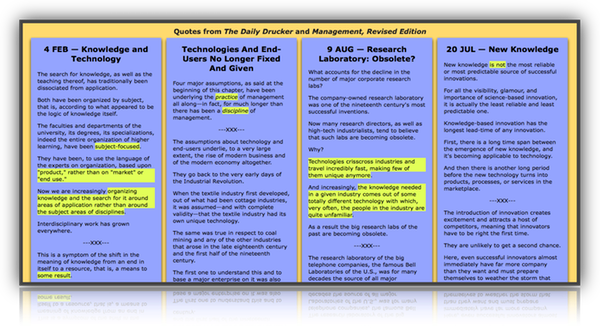
Read more — the modern chaos
Conclusion: With the recognition that our old mental patterns are unavoidably working against our long-term success, we need a way to repeatedly force ourselves to acquire the mental patterns that are adequate to the challenges we face.
A work approach and plan along with conceptual resources may be helpful. Conceptual resources are a way to force the brain to travel different roads.

What do you want to be remembered for?
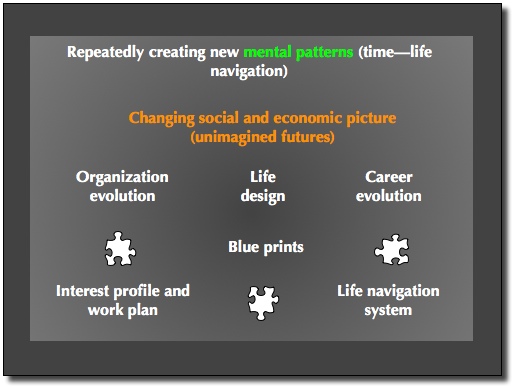
Connections:
TLN keywords: tlnkwmentalpatterns tlnkwbrain tlnkwpatterning tlnkwrecognition tlnkwfit
|
![]()

![]()